From The Kentucky Encyclopedia, edited by John Kleber. Copyright 1992. Reprinted with permission of The University Press of Kentucky
CASEY COUNTY. The forty-sixth in order of formation, Casey County was created on November 14, 1806, from Lincoln County, and named in honor of Col. William Casey, a Revolutionary War veteran from Virginia who explored the area in 1779. The 435-square-mile county is bordered by Russell, Pulaski, Lincoln, Boyle, Marion, Taylor, and Adair counties. Liberty, the county seat, was incorporated in 1830. Topography varies from dissected uplands to broad valleys with flat-topped ridges. The headwaters of the Green River and the Rolling Fork of the Salt River are the main water sources. Casey's 1850 population of 5,863 included 634 slaves. In 1870 the county produced 95,750 pounds of tobacco and 332,779 bushels of corn. In 1989, 71 percent of the land area was in farms and half of those were in cultivation. Casey ranks thirty-eighth among counties in agricultural receipts from tobacco, corn, hay, livestock, and vegetables. The county's 30,000 apple trees produce one-sixth of the state's crop. Early settlers arrived in 1779. Henry Quarles received a Virginia land grant for 1,000 acres in 1784. Prior to 1800, thirteen land grants for 3,022 acres were filed. While the population grew slowly, numerous travelers followed two trails across the county that connected Logan's Station at Stanford with settlements on the Green and Barren rivers to the west. The first county court met on May 4, 1807, and among other business, fixed rates on liquor, meals, and lodging at several taverns. Whiskey and brandy were eight cents and twelve cents a half-pint, respectively; breakfast was seventeen cents and dinner twenty-five cents; lodging was six cents a night. One of the families who settled in the county around 1781 was that of Capt. Abraham Lincoln, the president's grandfather. The Lincolns lived for two and a half years on eight hundred acres on the Green River. The land was sold in 1803 to Christopher Riffe for 400 pounds sterling by Mordecai Lincoln, Captain Lincoln's heir. Another landowner, Enoch Burdett, accumulated 13,000 acres of timberland, and upon his death in 1875, his holdings were sold to Eugene Zimmerman, a Cincinnati businessman. Zimmerman employed three hundred at his mills. In 1879 he built a wooden train track from Kings Mountain to Staffordsville, and in 1884 he organized the CINCINNATI & GREEN RIVER Railway Company. In 1891 when the timber resources were exhausted, he liquidated his holdings. The timber boom and early railroad had little lasting economic impact on the county. While there are no records of Civil War skirmishes in the county. Casey is credited with producing one-third of the 1st Kentucky Cavalry, recruited by Col. Frank Wolford and Col. Silas Adams, to serve in the Union army. The 1st Cavalry was active in the Battles of Mill Springs, Perryville, and Lebanon. Tennessee. Adams served as state representative and later in the 53d U.S. Congress (1893-95). Lumber continues to be an important segment of the economy, with five manufacturing firms producing wood products. Tourism and crude oil production also are staples of the economy. The Casey County Apple Festival each September features the baking of what is billed as the world's largest apple pie. Casey County's primary transportation route is U.S. 127. Casey County's population is approximately 15,000. |
|||||
